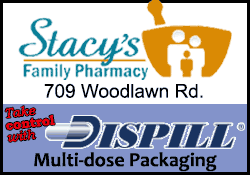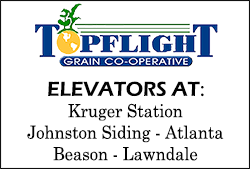|
 The American agricultural producers play a huge part in rural
America’s economic growth; job creation, and development,
through the service they offer to millions of rural producers. The American agricultural producers play a huge part in rural
America’s economic growth; job creation, and development,
through the service they offer to millions of rural producers.
As we await the farm land in Illinois to dry out for spring
planting, please contact your local County Farm Service Agency
Office to sign your 2018 ARC/PLC contracts. I am very pleased to
say that currently Illinois is right at, the half way point
through this year's ARC/PLC sign up.
It is a great honor to administer programs that enable Illinois
producers to manage their risks when the agricultural industry
faces hardship.
On behalf of Illinois Farm Service Agency staff and myself, I
would like to thank our agricultural producers for continuing to
feed our nation and the world.
William Graff

Payment Limitation
Program payments are limited by direct attribution to
individuals or entities. A legal entity is defined as an entity
created under Federal or State law that owns land or an
agricultural commodity, product or livestock. Through direct
attribution, payment limitation is based on the total payments
received by the individual, both directly and indirectly.
Qualifying spouses are eligible to be considered separate
persons for payment limitation purposes, rather than being
automatically combined under one limitation.
Payments and benefits under certain FSA programs are subject to
some or all of the following:
-
payment limitation by direct
attribution
-
payment limitation amounts for
the applicable programs
-
actively engaged in farming
requirements
-
cash-rent tenant rule
-
foreign person rule
-
average AGI limitations
-
programs subject to AGI
limitation
-
effective date of implementation
of AGI limitation
No program benefits subject to payment eligibility and
limitation will be provided until all required forms for the
specific situation are provided and necessary payment
eligibility and payment limitation determinations are made.
Payment eligibility and payment limitation determinations may be
initiated by the County Committee or requested by the producer.
There are statutory provisions that require entities, earning
program benefits that are subject to limitation, to provide the
names, addresses, and TINs of the entities’ members to the
County Committee.
All applicable payment eligibility and payment limitation forms
submitted by producers are subject to spot check through the
end-of-year review process.

Producers selected for end-of-year review must provide the
County Committee with operating loan documents, income and
expense ledgers, canceled checks for all expenditures, lease and
purchase agreements, sales contracts, property tax statements,
equipment listings, lease agreements, purchase contracts,
documentation of who provided actual labor and management,
employee time sheets or books, crop sales documents, warehouse
ledgers, gin ledgers, corporate or entity papers, etc.
A determination of not actively engaged in farming results in
the producer being ineligible for any payment or benefit
requiring a determination of actively engaged in farming.
Noncompliance with AGI provisions, either by exceeding the
applicable limitation or failure to submit a certification and
consent for disclosure statement, will result in the
determination of ineligibility for all program benefits subject
to AGI provisions. Program benefits shall be reduced in an
amount that is commensurate with the direct and indirect
interest held by an ineligible person or legal entity in any
legal entity, general partnership, or joint operation that
receives benefits subject to the average AGI limitations.
If any changes occur that could affect an actively engaged in
farming, cash-rent tenant, foreign person, or average Adjusted
Gross Income (AGI) determination, producers must timely notify
the County Office by filing revised farm operating plans and/or
supporting documentation, as applicable. Failure to timely
notify the County Office may adversely affect payment
eligibility.
Breaking New Ground
Agricultural producers are reminded to consult with FSA and NRCS
before breaking out new ground for production purposes as doing
so without prior authorization may put a producer’s federal farm
program benefits in jeopardy. This is especially true for land
that must meet Highly Erodible Land (HEL) and Wetland
Conservation (WC) provisions.
Producers with HEL determined soils are required to apply
tillage, crop residue and rotational requirements as specified
in their conservation plan.
Producers should notify FSA as a first point of contact prior to
conducting land clearing or drainage type projects to ensure the
proposed actions meet compliance criteria such as clearing any
trees to create new cropland, then these areas will need to be
reviewed to ensure such work will not risk your eligibility for
benefits.

Landowners and operators complete the form AD-1026 - Highly
Erodible Land Conservation (HELC) and Wetland Conservation (WC)
Certification to identify the proposed action and allow FSA to
determine whether a referral to Natural Resources Conservation
Service (NRCS) for further review is necessary.
Supervised Credit
Farm Service Agency (FSA) Farm Loan programs are considered
supervised credit. Unlike loans from a commercial lender, FSA
loans are intended to be temporary in nature. Therefore, it is
our goal to help you graduate to commercial credit, and our farm
loan staff is available to help borrowers through training and
credit counseling.
The FSA team will help borrowers identify their goals to ensure
financial success. Through this process, FSA staff will advise
borrowers in developing strategies and a plan to meet your
operation’s goals and graduate to commercial credit. Ultimately,
the borrower is responsible for the success of the farming
operation, but FSA’s staff will help in an advisory role to
provide the tools necessary to help you achieve your operational
goals and manage your finances.
For more information on FSA farm loan programs, visit
www.fsa.usda.gov.
Adjusted Gross Income Requirements
The average adjusted gross income (AGI) limitation for commodity
and disaster programs under the 2014 Farm Bill was changed to a
$900,000 limitation from all income sources. A person or legal
entity, other than a joint venture or general partnership, is
eligible to receive, directly or indirectly, certain program
payments or benefits if the average adjusted gross income of the
person or legal entity falls below the $900,000 threshold for
the three taxable years preceding the most immediately preceding
complete taxable year.
Reconstitutions
To be effective for the current Fiscal Year (FY), farm
combinations and farm divisions must be requested by August 1 of
the FY for farms subject to the Agriculture Risk Coverage (ARC)
and Price Loss Coverage (PLC) program. A reconstitution is
considered to be requested when all:
-
of the required signatures are
on form FSA-155
-
other applicable documentation,
such as proof of ownership, is submitted
Total Conservation Reserve Program (CRP) and non-ARC/PLC farms
may be reconstituted at any time.
[to top of second column] |

Reporting Wind Turbines Constructed on Cropland
Producers who have wind turbines constructed on their farms
should notify the local Farm Service Agency office. Any area
that is no longer considered suitable as cropland (producing
annual or perennial crops) should be designated in FSA’s records
and aerial photography maps. When base acres on a farm are
converted to a non-agricultural commercial or industrial use,
the total base acres on the farm must be reduced accordingly.
Non-cropland areas used for wind turbines might impact payments
calculated using base acres, such as Agriculture Risk Coverage
(ARC) and Price Loss Coverage (PLC).
Loan Servicing
There are options for Farm Service Agency loan customers during
financial stress. If you are a borrower who is unable to make
payments on a loan, contact your local FSA Farm Loan Manager to
learn about the options available to you.
Deadlines Approaching for FSA Livestock Disaster Assistance
Programs
Livestock producers are reminded that deadlines for the
Livestock Indemnity Program (LIP) are quickly approaching.
Producers with eligible livestock losses must submit a LIP
application for payment by March 31, 2018. LIP provides
assistance to eligible producers for livestock death losses in
excess of normal mortality due to adverse weather and attacks by
animals reintroduced into the wild by the federal government or
protected by federal law.

For 2017, eligible LIP losses must occur on or after Jan. 1,
2017, and no later than 60 calendar days from the ending date of
the applicable adverse weather event or attack. A notice of loss
must be filed with FSA within 30 days of when the loss of
livestock is apparent. Participants must provide the following
supporting documentation to their local FSA office no later than
90 calendar days after the end of the calendar year in which the
eligible loss condition occurred.
-
Proof of death documentation
-
Copy of growers contracts
-
Proof of normal mortality
documentation
Please contact your local FSA office to apply for LIP benefits.
Marketing Assistance Available for 2017 Crops
The 2014 Farm Bill authorized 2014-2018 crop year Marketing
Assistance Loans (MALs) and Loan Deficiency Payments (LDPs).
MALs provide financing and marketing assistance for 2017 crop
wheat, feed grains, soybeans and other oilseeds, pulse crops,
wool and honey. MALs provide producers interim financing after
harvest to help them meet cash flow needs without having to sell
their commodities when market prices are typically at
harvest-time lows.
A producer who is eligible to obtain an MAL, but agrees to forgo
the loan, may obtain an LDP if such a payment is available.
To be eligible for an MAL or an LDP, producers must have a
beneficial interest in the commodity, in addition to other
requirements. A producer retains beneficial interest when
control of and title to the commodity is maintained. For an LDP,
the producer must retain beneficial interest in the commodity
from the time of planting through the date the producer filed
Form CCC-633EZ (page 1) in the FSA County Office. For more
information, producers should contact their local FSA county
office or view the LDP Fact Sheet.
Farm Storage Facility Loans
FSA’s Farm Storage Facility Loan (FSFL) program provides
low-interest financing to producers to build or upgrade storage
facilities and to purchase portable (new or used) structures,
equipment and storage and handling trucks.

The low-interest funds can be used to build or upgrade permanent
facilities to store commodities. Eligible commodities include
corn, grain sorghum, rice, soybeans, oats, peanuts, wheat,
barley, minor oilseeds harvested as whole grain, pulse crops
(lentils, chickpeas and dry peas), hay, honey, renewable
biomass, fruits, nuts and vegetables for cold storage
facilities, floriculture, hops, maple sap, rye, milk, cheese,
butter, yogurt, meat and poultry (unprocessed), eggs, and
aquaculture (excluding systems that maintain live animals
through uptake and discharge of water). Qualified facilities
include grain bins, hay barns and cold storage facilities for
eligible commodities.
Loans up to $100,000 can be secured by a promissory
note/security agreement Loans exceeding $100,000 require
additional security.
Producers do not need to demonstrate the lack of commercial
credit availability to apply. The loans are designed to assist a
diverse range of farming operations, including small and
mid-sized businesses, new farmers, operations supplying local
food and farmers markets, non-traditional farm products, and
underserved producers.
To learn more about the FSA Farm Storage Facility Loan, visit
www.fsa.usda.gov/pricesupport or contact your local FSA county
office. To find your local FSA county office, visit http://offices.usda.gov.
Unauthorized Disposition of Grain
If loan grain has been disposed of through feeding, selling or
any other form of disposal without prior written authorization
from the county office staff, it is considered unauthorized
disposition. The financial penalties for unauthorized
dispositions are severe and a producer’s name will be placed on
a loan violation list for a two-year period. Always call before
you haul any grain under loan.
March Interest Rates and
Important Dates

Illinois Farm Service Agency
3500 Wabash Ave.
Springfield, IL 62711
Phone: 217-241-6600
Fax: 855-800-1760
www.fsa.usda.gov/il
State Executive Director:
William J. Graff
State Committee:
James Reed - Chairperson
Martin Barbre - Member
Melanie DeSutter - Member
Troy Uphoff - Member
Executive Officer:
Rick Graden
Administrative Officer:
Dan Puccetti
Division Chiefs:
Doug Bailey
John Gehrke
Randy Tillman
To find contact information for your local office go to
www.fsa.usda.gov/il
USDA is an equal
opportunity provider, employer and lender. To file a complaint of
discrimination, write: USDA, Office of the Assistant Secretary for
Civil Rights, Office of Adjudication, 1400 Independence Ave., SW,
Washington, DC 20250-9410 or call (866) 632-9992 (Toll-free Customer
Service), (800) 877-8339 (Local or Federal relay), (866) 377-8642
(Relay voice users).
 |